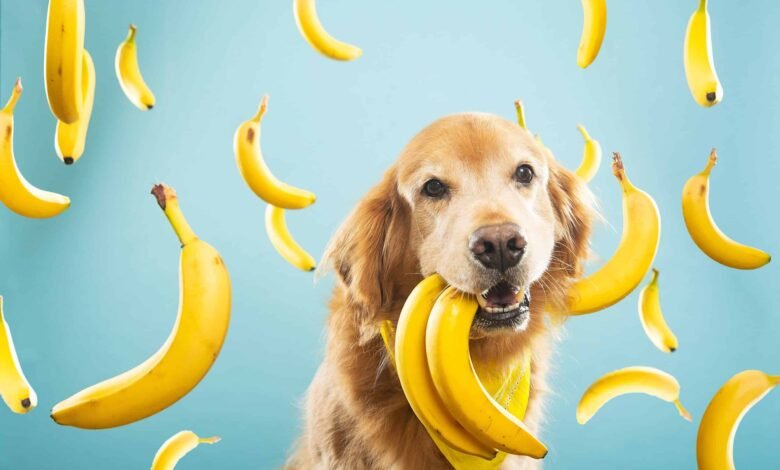What Happens if a Dog Eats a Banana Peel? Safety Tips

Welcome to the intriguing world of canine dietary exploration, where even the most seemingly harmless snacks can pose unexpected risks. In recent times, the topic of dogs consuming banana peels has emerged as a point of concern among pet owners and veterinary professionals alike. While bananas themselves are often considered a safe and healthy treat for dogs, the same cannot necessarily be said for their peels, which present a unique set of potential hazards.
As responsible pet owners, it’s essential to understand the risks associated with allowing our furry companions to nibble on banana peels. While dogs are known for their adventurous appetites, certain foods can pose serious threats to their health and well-being. Banana peels, in particular, may present risks such as digestive issues, potential pesticide contamination, and the risk of gastrointestinal blockages. Therefore, being aware of these potential hazards is crucial for safeguarding our dogs’ health and ensuring their safety.
In this article, we delve into the complexities of the risks associated with can dogs eat banana peels, providing valuable insights and safety tips for pet owners. By consulting with veterinary experts and exploring best practices for canine nutrition, we aim to equip readers with the knowledge they need to navigate this aspect of their dogs’ diets responsibly. Additionally, we’ll offer practical guidance on what to do if a dog consumes a banana peel, empowering pet owners to take prompt and appropriate action to protect their beloved companions. So, let’s embark on this journey together and unravel the mysteries surrounding dogs and banana peels.
Assessing Potential Risks to Canine Health
When considering the inclusion of banana peels in a dog’s diet, it’s essential for pet owners to assess potential risks to canine health. While banana peels offer nutritional benefits, they also present certain hazards that warrant careful consideration. In this section, we explore the risks associated with feeding banana peels to dogs, including the risk of gastrointestinal obstruction, potential allergic reactions, and concerns about pesticide residues or contaminants. Understanding these risks is crucial for making informed decisions that prioritize the safety and well-being of canine companions.
Risk of Gastrointestinal Obstruction:
- Tough Texture: Banana peels have a tough and fibrous texture that may pose a risk of gastrointestinal obstruction if consumed in large pieces.
- Blockages: Dogs may struggle to pass undigested banana peel, leading to blockages in the digestive tract and potential health complications.
- Symptoms: Symptoms of gastrointestinal obstruction may include vomiting, abdominal pain, lethargy, and loss of appetite.
Potential Allergic Reactions or Sensitivities:
- Individual Sensitivity: Some dogs may be allergic or sensitive to components found in banana peels, such as certain proteins or compounds.
- Manifestation: Allergic reactions can manifest as skin irritation, itching, gastrointestinal upset, or respiratory symptoms.
- Variable Responses: Sensitivity to banana peels may vary among individuals, necessitating careful observation and monitoring.
Concerns about Pesticide Residues or Contaminants:
- Exposure to Pesticides: Banana peels may harbor pesticide residues from agricultural practices, posing potential health risks to dogs.
- Health Effects: Ingesting pesticide residues can lead to gastrointestinal upset, neurological symptoms, and long-term health effects.
- Preventive Measures: Pet owners should consider washing banana peels thoroughly or opting for organic varieties to minimize exposure to contaminants.
By assessing these potential risks to canine health, pet owners can make informed decisions about whether to include banana peels in their dogs’ diets. Prioritizing safety and well-being requires proactive measures to mitigate risks and ensure responsible dietary choices for dogs.
Immediate Steps to Take if a Dog Eats a Banana Peel
Discovering that a dog has eaten a banana peel can be concerning for pet owners, as banana peels may pose risks to canine health if consumed in large quantities or if the dog experiences adverse reactions. Taking immediate steps to address the situation is crucial to ensure the well-being of the dog. In this section, we outline the immediate steps to take if a dog eats a banana peel, including contacting a veterinarian for guidance and advice, monitoring the dog for any signs of distress or discomfort, and providing supportive care as recommended by the veterinarian.
Contacting a Veterinarian Immediately:
- Urgent Response: Upon discovering that a dog has ingested a banana peel, pet owners should contact a veterinarian immediately for guidance and advice.
- Professional Assessment: Veterinarians can provide timely assessment and recommendations based on the individual circumstances, including the dog’s size, health status, and the amount of banana peel ingested.
- Emergency Assistance: In cases of suspected gastrointestinal obstruction or severe adverse reactions, prompt veterinary attention is essential to prevent complications and ensure appropriate treatment.
Monitoring the Dog for Signs of Distress or Discomfort:
- Vigilant Observation: Pet owners should closely monitor the dog for any signs of distress or discomfort following the ingestion of a banana peel.
- Symptoms to Watch For: Symptoms may include vomiting, diarrhea, abdominal pain, lethargy, loss of appetite, difficulty breathing, or unusual behavior.
- Documentation: Keeping a record of observed symptoms and changes in the dog’s condition can help veterinarians assess the situation and determine appropriate next steps.
Providing Supportive Care as Recommended by the Veterinarian:
- Follow Veterinary Advice: Pet owners should follow the recommendations provided by the veterinarian for supportive care and management of any adverse reactions.
- Home Care Measures: Depending on the severity of the situation, supportive care measures may include providing fluids, monitoring hydration, and offering bland or easily digestible food.
- Follow-Up Care: Veterinarians may recommend follow-up appointments or monitoring to ensure the dog’s recovery and address any ongoing concerns.
By taking immediate action and following these steps, pet owners can effectively address the situation if a dog eats a banana peel and ensure the best possible outcome for their canine companion. Prioritizing prompt veterinary care and vigilant monitoring is essential in managing potential risks and safeguarding the health and well-being of dogs.
Understanding the Potential Effects on Canine Digestive Health
The digestive health of dogs is of utmost importance for their overall well-being, and understanding how certain foods, like banana peels, can affect their digestive tract is crucial for pet owners. While banana peels offer potential benefits, they also pose risks that can impact canine digestive health. In this section, we explore how banana peels can affect the digestive tract of dogs, the risks of gastrointestinal obstruction, and the importance of seeking veterinary attention if digestive issues arise after a dog consumes a banana peel.
How Banana Peels Can Affect the Digestive Tract of Dogs:
- Fiber Content: Banana peels contain dietary fiber, which can aid digestion by promoting bowel regularity and supporting gastrointestinal health.
- Texture: The tough and fibrous texture of banana peels may pose challenges for dogs to digest, particularly if consumed in large pieces.
- Potential Irritants: Certain compounds in banana peels, such as cellulose and tannins, may irritate the digestive tract of some dogs, leading to discomfort or digestive upset.
Risks of Gastrointestinal Obstruction and Potential Symptoms to Watch For:
- Obstruction Risk: The tough texture of banana peels can increase the risk of gastrointestinal obstruction if large pieces are ingested and not adequately broken down.
- Symptoms: Symptoms of gastrointestinal obstruction may include vomiting, diarrhea, abdominal pain, bloating, lethargy, loss of appetite, and difficulty defecating.
- Serious Complications: Gastrointestinal obstruction can lead to serious complications if not promptly addressed, including bowel perforation and systemic infection.
Importance of Seeking Veterinary Attention if Digestive Issues Arise:
- Prompt Evaluation: If a dog exhibits symptoms of digestive issues after consuming a banana peel, it’s essential to seek veterinary attention promptly.
- Professional Assessment: Veterinarians can assess the dog’s condition, perform diagnostic tests if necessary, and provide appropriate treatment to address any gastrointestinal issues.
- Preventing Complications: Timely veterinary intervention can help prevent complications, such as severe gastrointestinal obstruction, and ensure the dog receives the necessary care to support recovery.
By understanding the potential effects of banana peels on canine digestive health, pet owners can take proactive measures to mitigate risks and prioritize their dog’s well-being. Monitoring for symptoms of digestive issues and seeking veterinary attention if concerns arise are essential steps in safeguarding the digestive health of dogs and promoting overall health and vitality.
Safety Tips for Preventing Accidental Ingestion
Preventing accidental ingestion of banana peels by dogs is essential for maintaining their safety and well-being. While banana peels may seem harmless to humans, they can pose risks to canine health if ingested inappropriately. In this section, we outline safety tips for pet owners to prevent accidental ingestion of banana peels by their dogs, emphasizing proper disposal, keeping bananas out of reach, and educating household members and visitors about potential hazards.
Properly Disposing of Banana Peels in a Secure Trash Receptacle:
- Secure Disposal: After consuming bananas, pet owners should ensure that banana peels are disposed of promptly and securely in a trash receptacle with a secure lid.
- Prevent Access: Keeping banana peels out of reach of dogs helps prevent them from scavenging and potentially ingesting them accidentally.
- Avoid Outdoor Exposure: Avoid leaving banana peels in outdoor areas accessible to dogs, as this increases the risk of ingestion.
Keeping Bananas and Banana Peels Out of Reach of Dogs:
- Elevated Storage: Store bananas in elevated or closed containers, cabinets, or refrigerators where dogs cannot access them.
- Supervision: When handling bananas or preparing meals containing banana peels, ensure that dogs are supervised and kept away from the area to prevent accidental ingestion.
- Training: Consider training dogs to avoid scavenging behaviors and reinforcing boundaries to prevent access to potentially harmful items.
Educating Household Members and Visitors about Potential Hazards:
- Awareness: Educate household members and visitors about the potential hazards of dogs consuming banana peels, emphasizing the importance of keeping them out of reach.
- Clear Communication: Clearly communicate guidelines for handling and disposing of bananas and banana peels to prevent accidental ingestion by dogs.
- Vigilance: Encourage vigilance among household members and visitors to ensure that bananas and banana peels are stored securely and disposed of properly to minimize risks.
By following these safety tips, pet owners can reduce the likelihood of accidental ingestion of banana peels by their dogs and promote a safe and healthy environment for their canine companions. Prevention is key in safeguarding canine health and preventing potential complications associated with ingesting inappropriate items.
Conclusion: Prioritizing Canine Safety
Ensuring the safety of our canine companions is a top priority for pet owners, and proactive measures are essential in preventing potential risks associated with ingesting harmful items like banana peels. In this article, we’ve explored various aspects of the topic, from understanding the potential effects on canine health to safety tips for preventing accidental ingestion. As responsible pet owners, it’s crucial to prioritize canine safety and take proactive steps to minimize risks to our dogs. In this concluding section, we summarize the key points discussed in the article and emphasize the importance of remaining vigilant and seeking prompt veterinary attention if needed.
Summary of Key Points Discussed:
Potential Risks: We’ve highlighted the potential risks associated with dogs consuming banana peels, including gastrointestinal obstruction, allergic reactions, and exposure to pesticide residues.
Safe Feeding Practices: We’ve outlined guidelines for safe feeding practices, including proper preparation methods, serving sizes, and monitoring for any signs of digestive issues or adverse reactions.
Immediate Steps: We’ve discussed immediate steps to take if a dog eats a banana peel, such as contacting a veterinarian, monitoring for symptoms, and providing supportive care as recommended.
Preventive Measures: We’ve provided safety tips for preventing accidental ingestion, including properly disposing of banana peels, keeping bananas out of reach, and educating household members and visitors about potential hazards.
Emphasis on Proactive Measures:
Prioritizing Canine Safety: The well-being of our dogs is paramount, and proactive measures are essential in safeguarding their health and preventing potential hazards.
Vigilance: Staying vigilant and proactive in preventing dogs from eating banana peels can help minimize risks and ensure a safe environment for our canine companions.
Encouragement for Dog Owners:
Stay Informed: We encourage dog owners to stay informed about potential hazards and safety practices related to their dog’s diet and environment.
Seek Veterinary Attention: In the event that a dog ingests a banana peel or experiences any adverse reactions, we encourage pet owners to seek veterinary attention promptly for evaluation and treatment.
By prioritizing canine safety and taking proactive measures to prevent risks, pet owners can provide a safe and healthy environment for their beloved dogs. Remaining vigilant and seeking veterinary attention when needed are essential steps in ensuring the well-being of our canine companions.



